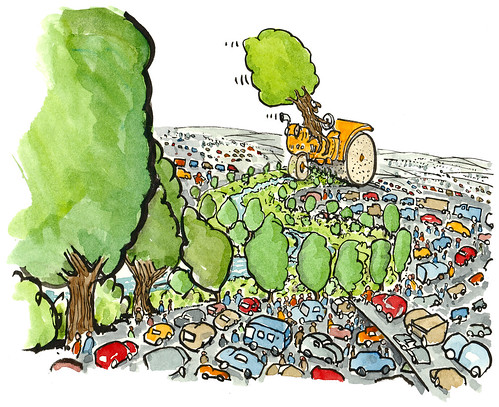The Comics Journalist

flickr photo shared by Frits Ahlefeldt, Hiking.org under a Creative Commons ( BY-NC-ND ) license
Introduction
In the recent years, printed newspapers have been increasingly losing readership. This is where experimenting with digital technology and alternative ways of storytelling enter into the equation. For example, imagine reading a disturbing news story, heavy with grim statistics and imagine watching a cartoon with characters in it? Which one would you prefer? That’s right - most people would go for the cartoon, simply because it draws us in with its lightness, while at the same time presenting a serious topic. It also introduces real characters and it makes it easier for the receiver to identify with the story. Most people do not enjoy reading long reports about a grave issue, but what if there was a way to learn about grave issues in the world in a fun, light-hearted way? Indeed there is - it is called comics journalism and it is a rather flourishing branch!
Comics journalism is a new form of journalism. It empowers a person to report on an issue with the help of visual stories i.e. comics. As impartial as possible, showing the struggle, conflicts and happiness of people, but also sometimes showing journalist’s own struggle with being there with these people, reporting on their lives. To become a Comics Journalist, one does not need to be both a journalist and a comic artist or even none of them. Two parts of the newspaper were effectively combined. In the next activity, we challenge you to try it out yourself.
Activity Type
Individual / Experiential
Duration
One day
Learning Outcomes
To become aware of the influence of different media and perspectives
To develop an impartial perspective
Instructions
Required Materials and Tools:
Drawing tools. You can start with a pencil and an eraser, but you might want to make it a bit more fancy, get some colours, and ink your grey pencil lines. You can finish your drawings on the computer with effects (for which you would need a computer and a program like Photoshop), but always start with real paper.
Step-by-Step Instructions:
Go through the local newspaper, or talk in the group about what should actually be in there and what you are willing to make research on and report on.
You are a comics journalist now and you want to convey a message through comics. Find something that interests you, it does not have to be serious, new or an exclusive story.
Train some drawing on the subject you are going to focus on, for instance if are you going to report about a farm, it would be good if you are able to draw a cow. And how would you draw yourself? Any style is good enough. Crappy artists have become comic book stars.
Go to your reporting assignment. Take both drawing and text notes. You can also film, and record with a camera. Be careful that you do not disappear behind it though. Neither should you later copy everything one on one from the video material. Just use it as a reminder of who was present and what the surroundings generally looked like. The whole point is you that you will document YOUR experience and paint this perspective.
Sit down, think of what you want to tell. You can start to sketch right away, but let the story come together at a slow pace.
Design your spread, the different boxes of the story and think of what will happen where.
Draw as much a possible. The things that are not clear can be explained in descriptions, or text balloons.
Resources
Reflection
Was it difficult to remain impartial while reporting?
Was it difficult for you to present a serious topic through comics?
Do you feel that comics journalism can convey the message easier than traditional journalism?
Instructions for Submission
Scan and upload your journalistic comic (1 photo). Submit a short summary of your answers to the questions from the Reflection section. Instructions on how to upload photos and how to submit things in Moodle can be found here: Instructions on Submission&Uploading
Instructions for Assessment
Provide feedback to at least one participant that has done this activity. Instructions on providing feedback can be found here: Instructions on Feedback
Related Topics
New Journalism